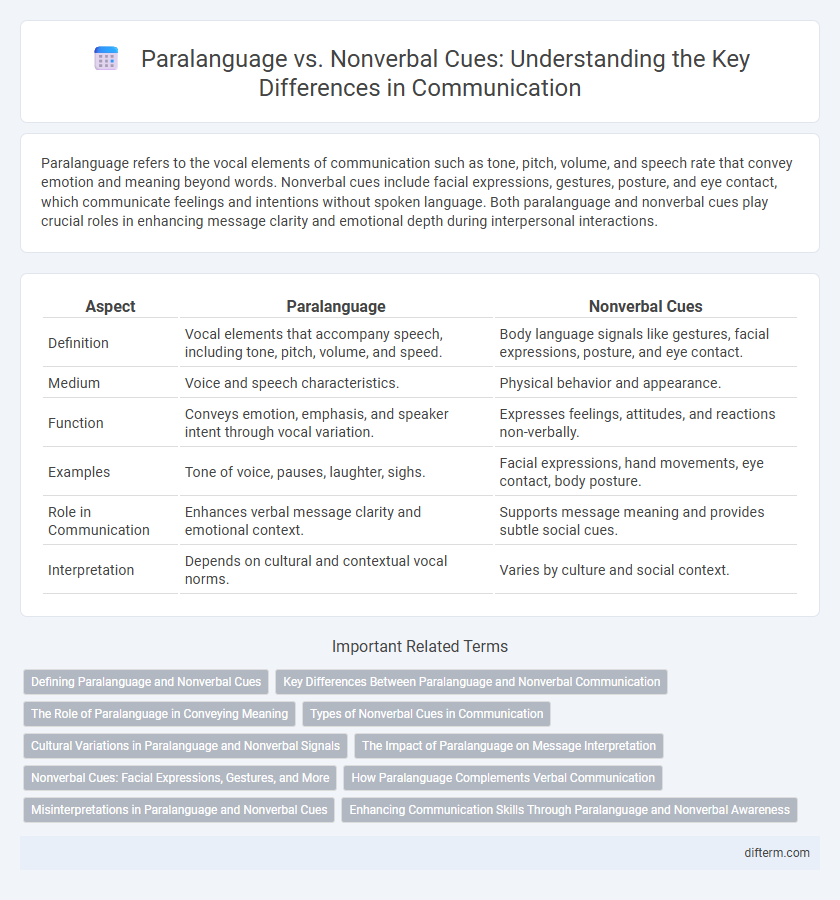Paralanguage refers to the vocal elements of communication such as tone, pitch, volume, and speech rate that convey emotion and meaning beyond words. Nonverbal cues include facial expressions, gestures, posture, and eye contact, which communicate feelings and intentions without spoken language. Both paralanguage and nonverbal cues play crucial roles in enhancing message clarity and emotional depth during interpersonal interactions.
Table of Comparison
| Aspect | Paralanguage | Nonverbal Cues |
|---|---|---|
| Definition | Vocal elements that accompany speech, including tone, pitch, volume, and speed. | Body language signals like gestures, facial expressions, posture, and eye contact. |
| Medium | Voice and speech characteristics. | Physical behavior and appearance. |
| Function | Conveys emotion, emphasis, and speaker intent through vocal variation. | Expresses feelings, attitudes, and reactions non-verbally. |
| Examples | Tone of voice, pauses, laughter, sighs. | Facial expressions, hand movements, eye contact, body posture. |
| Role in Communication | Enhances verbal message clarity and emotional context. | Supports message meaning and provides subtle social cues. |
| Interpretation | Depends on cultural and contextual vocal norms. | Varies by culture and social context. |
Defining Paralanguage and Nonverbal Cues
Paralanguage refers to the vocal elements of communication such as tone, pitch, volume, and speech rate that convey meaning beyond the actual words spoken. Nonverbal cues encompass body language, facial expressions, gestures, posture, and eye contact, which communicate emotions and intentions without spoken language. Both paralanguage and nonverbal cues play essential roles in enhancing message clarity and emotional expression during interpersonal communication.
Key Differences Between Paralanguage and Nonverbal Communication
Paralanguage involves vocal elements such as tone, pitch, volume, and speech rate that convey meaning beyond words, while nonverbal communication encompasses body language, facial expressions, gestures, posture, and eye contact. Paralanguage modifies the way verbal messages are delivered, directly influencing interpretation, whereas nonverbal cues often communicate emotions and attitudes independently of speech. Understanding the distinction enhances effective communication by recognizing how vocal nuances and physical behaviors complement or contradict spoken language.
The Role of Paralanguage in Conveying Meaning
Paralanguage encompasses vocal elements such as tone, pitch, volume, and speech rate that modify the meaning of spoken words, significantly impacting communication effectiveness. These vocal cues provide emotional context, reveal speaker attitudes, and clarify intent beyond the literal message, making them essential in conveying subtle nuances. Understanding paralanguage enhances interpersonal understanding by interpreting underlying feelings and attitudes that nonverbal cues alone may not fully express.
Types of Nonverbal Cues in Communication
Nonverbal cues in communication encompass facial expressions, gestures, posture, eye contact, and proxemics, all conveying emotions and intentions without spoken words. Paralanguage, a subset of nonverbal communication, includes vocal elements such as tone, pitch, volume, and speech rate, which modify the meaning of verbal messages. Understanding these nonverbal signals enhances interpretation accuracy and strengthens interpersonal communication effectiveness.
Cultural Variations in Paralanguage and Nonverbal Signals
Paralanguage and nonverbal cues exhibit significant cultural variations that influence communication effectiveness; for instance, tone, pitch, and speech rate vary globally, affecting how messages are interpreted across different societies. In cultures such as Japan, silence and subtle vocal inflections convey respect and attentiveness, while in Mediterranean cultures, expressive intonation and dynamic gestures dominate social interactions. Understanding these cultural nuances in paralanguage and nonverbal behavior is crucial for cross-cultural communication, reducing misunderstandings and enhancing interpersonal connections.
The Impact of Paralanguage on Message Interpretation
Paralanguage, including tone, pitch, and speech rate, significantly influences how messages are interpreted by adding emotional context beyond the literal words spoken. Variations in vocal elements can convey sarcasm, urgency, or confidence, shaping the receiver's understanding and response. Unlike static nonverbal cues such as facial expressions or gestures, paralanguage dynamically modulates verbal communication to enrich or alter meaning during interactions.
Nonverbal Cues: Facial Expressions, Gestures, and More
Nonverbal cues such as facial expressions, gestures, posture, and eye contact play a crucial role in communication by conveying emotions and intentions without spoken words. Facial expressions like smiles, frowns, and raised eyebrows provide instant feedback and enhance message clarity, while gestures like hand movements and nodding support or emphasize verbal content. These nonverbal signals create a deeper understanding during interactions, often revealing true feelings and attitudes beyond the literal meaning of speech.
How Paralanguage Complements Verbal Communication
Paralanguage enhances verbal communication by conveying emotions, attitudes, and emphasis through tone, pitch, volume, and speech rate, providing depth beyond the literal words spoken. It clarifies the speaker's intent, reduces ambiguity, and helps listeners interpret the message accurately in various contexts such as negotiations, presentations, and casual conversations. Nonverbal cues like facial expressions and gestures work alongside paralanguage to create a richer, more nuanced communication experience.
Misinterpretations in Paralanguage and Nonverbal Cues
Misinterpretations in paralanguage often arise from variations in tone, pitch, and pace, leading to misunderstandings of the speaker's emotional state or intent. Nonverbal cues such as gestures, facial expressions, and body language can be misread due to cultural differences or context, causing incorrect assumptions about feelings or attitudes. Effective communication requires awareness of these paralanguage and nonverbal variations to minimize misinterpretations and enhance clarity.
Enhancing Communication Skills Through Paralanguage and Nonverbal Awareness
Paralanguage, including tone, pitch, and volume, significantly influences how messages are perceived beyond spoken words, while nonverbal cues like facial expressions, gestures, and posture provide essential context and emotional depth. Mastering the interpretation and control of these elements enhances communication skills by fostering clearer understanding and stronger interpersonal connections. Awareness of both paralanguage and nonverbal signals helps reduce misunderstandings and improves the effectiveness of verbal exchanges in personal and professional settings.
Paralanguage vs Nonverbal Cues Infographic

 difterm.com
difterm.com